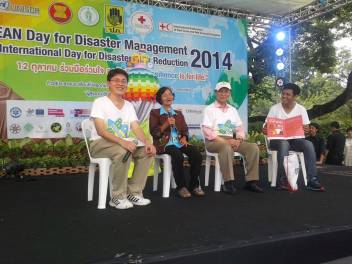 Even as HelpAge’s regional office for East Asia and its partners were preparing for the International Day of Disaster Reduction (IDDR) and the ASEAN Day of Disaster Management (ADDM), Typhoon Vongfong was bearing down on Japan and Typhoon Hudhud on the eastern coast of India. Both were termed to be close to the level of Typhoon Haiyan. Both countries, waited with bated breath, expecting the worst.
Even as HelpAge’s regional office for East Asia and its partners were preparing for the International Day of Disaster Reduction (IDDR) and the ASEAN Day of Disaster Management (ADDM), Typhoon Vongfong was bearing down on Japan and Typhoon Hudhud on the eastern coast of India. Both were termed to be close to the level of Typhoon Haiyan. Both countries, waited with bated breath, expecting the worst.
Typhoon Vongfong, the strongest storm to hit Japan this year, caused significant damage to property and infrastructure but by and large, people’s lives were spared. Reuters reported two deaths – one a 90-year-old man and the other a 72-year-old man. Both older people.
India is still counting the cost of the destruction caused by Typhoon Hudhud. The storm which was classified as “very severe”, flattened trees, communication towers, electric posts, bridges and hoardings and created large scale destruction in the states of Andhra Pradesh and Odisha. The latest figure for the number of dead stands at eight.
Success of disaster risk reduction
In the past, typhoons and storms of similar strength have killed hundreds of people on the sub-continent. This time it was only eight.
The reduced numbers from India and Japan is clearly a success of the DRR programmes put in place globally and in particular, countries considered more at risk to natural disasters.
This clearly demonstrates the value of DRR in saving precious lives and strengthens the argument for donors and agencies to invest more in building resiliency.
More needs to be done to protect older people
The two deaths in Japan were older people. No details yet about the age of those who died in India, but I suspect half of them will be older.
Over 55% of the people who died in Hurricane Katrina and the Great Eastern Earthquake and Tsunami in Japan were aged 60 and over. Why is this the case? Why are we failing our senior citizens? This calls for a serious review of the existing DRR policy and programmes.
This year, the UN theme of the IDDR is “Resilience for Life” with the focus being on older people. Events are being held globally over the next two weeks. Our event in Bangkok was held on 12 October at the Lumpini Park.
It was jointly organised by the Department of Disaster Prevention and Mitigation, Thailand (DDPM), UNISDR, the Thai Red Cross and HelpAge. The national DRR network took part in many events on the day and older people played a key role as well.
Highlighting older people’s contributions
HelpAge is changing the narrative of older people only being considered as vulnerable by also promoting their resourcefulness and contributions in DRR and resilience. This is “Resilience for Life”.
Events are being held in several ASEAN countries and our staff will promote throughout the region. The support for the theme of “older people” has been very significant from our Affiliates and partners in the region. World Vision, one of the ASEAN Partnership Group (APG) has produced infographics to commemorate the theme.
The message on a bag made by an older people’s associations in the Philippines for IDDR read: “we’re not afraid anymore because we’re better prepared”.
May this be the pillar on which communities and nations build their resilience.
Find out more about International Day for Disaster Reduction.
Download Disaster Resilience in an Ageing World: How to make policies and programmes inclusive of older people (1.9mb)
